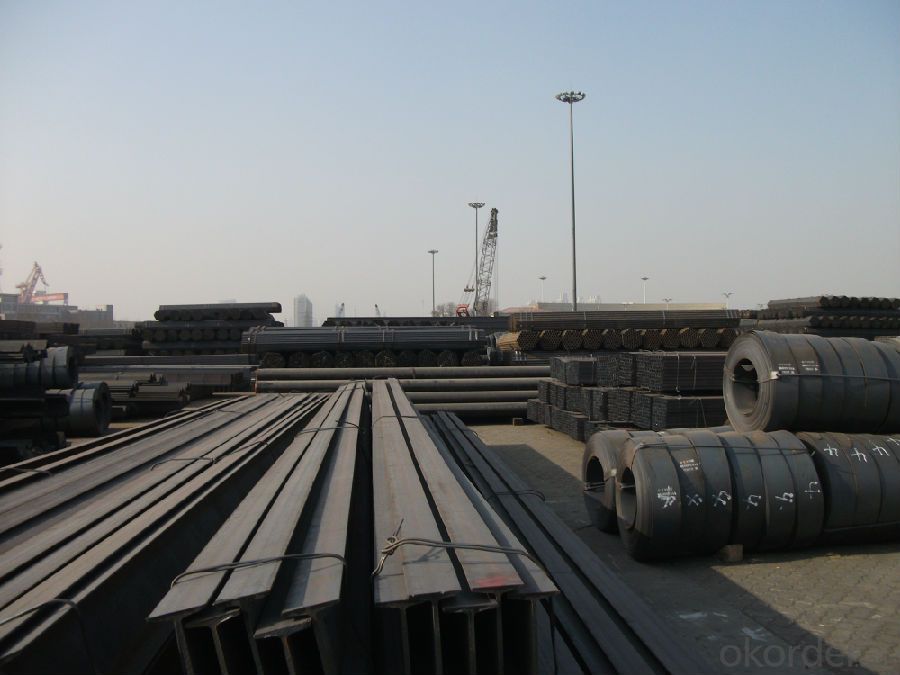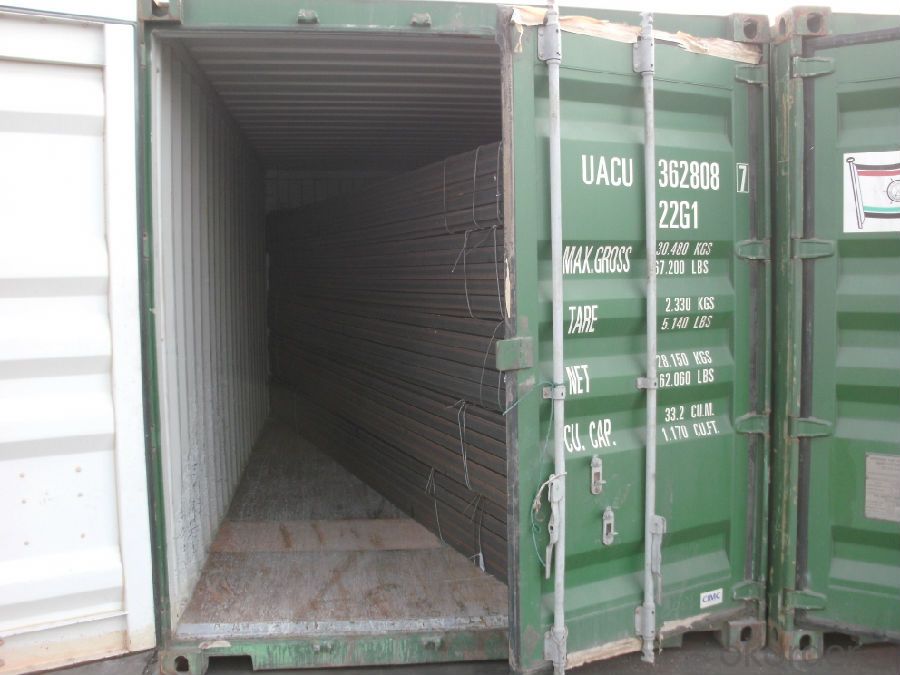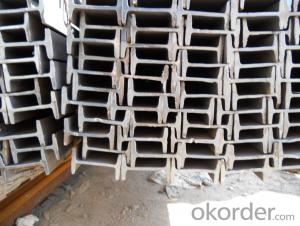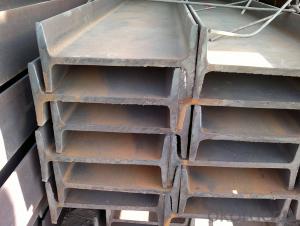Hot Rolled Steel I Beams for Construction from China
- Loading Port:
- Tianjin
- Payment Terms:
- TT OR LC
- Min Order Qty:
- 25 m.t
- Supply Capability:
- 200000 m.t/month
OKorder Service Pledge
OKorder Financial Service
You Might Also Like
Item specifice
Product Description:
OKorder is offering Hot Rolled Steel I Beams for Construction from China at great prices with worldwide shipping. Our supplier is a world-class manufacturer of steel, with our products utilized the world over. OKorder annually supplies products to European, North American and Asian markets. We provide quotations within 24 hours of receiving an inquiry and guarantee competitive prices.
Product Applications:
Hot Rolled Steel I Beams for Construction from China are widely used in various construction structures, bridges, autos, brackets, mechanisms and so on.
Product Advantages:
OKorder's Hot Rolled Steel I Beams for Construction from China are durable, strong, and resist corrosion.
Main Product Features:
· Premium quality
· Prompt delivery & seaworthy packing (30 days after receiving deposit)
· Corrosion resistance
· Can be recycled and reused
· Mill test certification
· Professional Service
· Competitive pricing
Product Specifications:
1. Product name: Hot Rolled Steel I Beams for Construction from China
2. Standard: EN10025, GB Standard, ASTM, JIS etc.
3. Grade: Q235B, A36, S235JR, Q345, SS400 or other equivalent.
4. Length: 5.8M, 6M, 9M, 10M, 12M or as your requirements

Section | Standard Sectional Dimensions(mm) | ||||
h | b | s | t | Mass Kg/m | |
IPE80 | 80 | 46 | 3.80 | 5.20 | 6.00 |
IPE100 | 100 | 55 | 4.10 | 5.70 | 8.10 |
IPE120 | 120 | 64 | 4.80 | 6.30 | 10.40 |
IPE140 | 140 | 73 | 4.70 | 6.90 | 12.90 |
IPE160 | 160 | 82 | 5.00 | 7.40 | 15.80 |
IPE180 | 180 | 91 | 5.30 | 8.00 | 18.80 |
IPE200 | 200 | 100 | 5.60 | 8.50 | 22.40 |
IPE220 | 220 | 110 | 5.90 | 9.20 | 26.20 |
IPE240 | 240 | 120 | 6.20 | 9.80 | 30.70 |
IPE270 | 270 | 135 | 6.60 | 10.20 | 36.10 |
IPEAA80 | 80 | 46 | 3.20 | 4.20 | 4.95 |
IPEAA100 | 100 | 55 | 3.60 | 4.50 | 6.72 |
IPEAA120 | 120 | 64 | 3.80 | 4.80 | 8.36 |
IPEAA140 | 140 | 73 | 3.80 | 5.20 | 10.05 |
IPEAA160 | 160 | 82 | 4.00 | 5.60 | 12.31 |
IPEAA180 | 180 | 91 | 4.30 | 6.50 | 15.40 |
IPEAA200 | 200 | 100 | 4.50 | 6.70 | 17.95 |
5.Color marking: There will be color marking on both end of the bundle for the cargo delivered by bulk vessel. That makes it easily to distinguish at the destination port.
Tag mark: there will be tag mark tied up on the bundles. The information usually including supplier logo and name, product name, made in China, shipping marks and other information request by the customer.
If loading by container the marking is not needed, but we will prepare it as customer request.
6. Shipment: In containers or in bulk cargo
FAQ:
Q1: Why buy Hot Rolled Steel I Beams for Construction from China from OKorder.com?
A1: All products are carefully selected from China's most reliable manufacturing enterprises. Through its ISO certifications, OKorder.com adheres to the highest standards and a commitment to supply chain safety and customer satisfaction. We can guarantee the quality!
Q2: The products are invoicing on theoretical weight or on actual weight?
A2: We can do it in both manners, it’s according to buyer's requirement.
Q3: Can you offer the third part inspection certificates ?
A3: Yes, we can apply third part inspection before shipping, such as SGS, BV, etc .
Images:


- Q:Can Steel I-Beams be used for outdoor structures like pergolas?
- Yes, Steel I-Beams can be used for outdoor structures like pergolas. Steel I-Beams are known for their strength, durability, and load-bearing capacity, making them suitable for various applications, including pergolas. They provide excellent support for the structure and can withstand outdoor elements such as wind, rain, and snow. Additionally, steel I-beams can be designed to be resistant to corrosion, ensuring a long lifespan even in harsh outdoor conditions. Their versatility allows for customization and the ability to create unique and modern designs for outdoor structures like pergolas.
- Q:Can steel I-beams be used for support columns?
- Yes, steel I-beams can be used as support columns. They are commonly employed in construction projects as they provide excellent strength, stability, and load-bearing capacity, making them suitable for supporting heavy loads in structures such as buildings, bridges, and industrial facilities.
- Q:What are the different connection methods for Steel I-Beams?
- There are several different connection methods for Steel I-Beams, depending on the specific application and structural requirements. Some of the common connection methods include: 1. Welding: This is the most common method used to connect steel I-beams. It involves melting the base metal and applying a filler material to create a strong joint. Welding provides excellent strength and rigidity, making it suitable for heavy-duty applications. 2. Bolting: Bolts can be used to connect steel I-beams together. This method involves drilling holes in the flanges or web of the I-beams and inserting bolts through these holes, along with washers and nuts, to tighten and secure the connection. Bolting provides ease of installation and disassembly, making it suitable for temporary or adjustable structures. 3. Riveting: Rivets are another traditional method of connecting steel I-beams. This process involves inserting a rivet through pre-drilled holes in the flanges or web of the I-beams and then deforming the rivet to create a permanent connection. Riveting provides high strength and reliability but requires specialized tools and expertise. 4. Adhesive bonding: In some cases, adhesive bonding can be used to connect steel I-beams. This method involves applying a high-strength adhesive to the surfaces of the I-beams and then pressing them together to create a bond. Adhesive bonding can provide a clean and aesthetically pleasing connection, but it may not be suitable for heavy loads or dynamic loads. 5. Mechanical connectors: There are various mechanical connectors available in the market specifically designed for connecting steel I-beams. These connectors are often prefabricated and can be easily installed by bolting or welding. They provide a quick and efficient method of connecting I-beams while maintaining high strength and load-bearing capacity. It is important to consider the specific structural requirements, load conditions, and design constraints when selecting the appropriate connection method for steel I-beams. Consulting with a structural engineer or a qualified professional is recommended to ensure the chosen connection method meets the necessary standards and specifications.
- Q:What are the different types of steel reinforcements for I-beams?
- I-beams can be reinforced using various types of steel, each possessing unique characteristics and advantages. Hot-rolled steel, for instance, is a commonly used reinforcement. To manufacture this type of reinforcement, the steel billet or ingot is heated to high temperatures and then rolled into the desired shape. Known for their exceptional strength and durability, hot-rolled steel reinforcements are ideal for heavy-duty applications like constructing bridges and high-rise buildings. Another popular option for reinforcing I-beams is cold-formed steel. This type of reinforcement is created by bending or shaping cold steel sheets or strips into the desired form. Cold-formed steel reinforcements are frequently utilized in light structural applications, such as residential construction, due to their cost-effectiveness and ease of fabrication. Apart from hot-rolled and cold-formed steel reinforcements, there are also specialized types available. For instance, stainless steel reinforcements are often employed in environments where corrosion resistance is crucial, such as coastal areas or chemical plants. Additionally, carbon steel reinforcements are widely used in numerous applications due to their affordability and high strength. It is important to note that the choice of steel reinforcement for I-beams depends on several factors, including structural requirements, load-bearing capacity, and environmental conditions. Engineers and architects carefully consider these factors when selecting the appropriate type of steel reinforcement to ensure the safety and longevity of the structure.
- Q:Help: how can I sample steel beams?
- Cold is generally two times the thickness, tensile tensile and bending no specific requirements, the size of 450mm and 350mm, the sampling method can be used to blow out the slightly larger cutting requirements size, and then use the milling machine, cutting will affect regional removal.
- Q:What is the typical span length for steel I-beams?
- The typical span length for steel I-beams can vary depending on several factors such as the load they need to support, the type of construction, and the specific design requirements. However, in general, steel I-beams can have span lengths ranging from 10 feet to over 100 feet. The span length is determined by considering the maximum allowable deflection, the weight and distribution of the load, and the properties of the steel beam itself. Structural engineers and architects typically calculate the appropriate span length for steel I-beams based on these factors to ensure structural stability and safety.
- Q:Can steel I-beams be used in exterior applications?
- Yes, steel I-beams can be used in exterior applications. Steel I-beams are commonly used in construction for their strength and durability, making them suitable for exterior applications where load-bearing capabilities are required. They are often used in the construction of bridges, highways, and industrial buildings, as well as for supporting large structures such as stadiums and warehouses. Steel I-beams can withstand harsh weather conditions, including extreme temperatures, high winds, and heavy rain or snowfall, making them a reliable choice for outdoor applications. Additionally, steel can be coated or galvanized to protect against corrosion, further enhancing its suitability for exterior use.
- Q:Can steel I-beams be customized for specific project requirements?
- Yes, steel I-beams can be customized for specific project requirements. They can be fabricated in various sizes, lengths, and shapes to meet the specific needs of a project, such as supporting heavy loads or spanning long distances. Additionally, steel I-beams can be customized with additional features like holes, notches, or coatings to enhance their performance and compatibility with the project requirements.
- Q:Can steel I-beams be used in agricultural or rural construction projects?
- Yes, steel I-beams can definitely be used in agricultural or rural construction projects. Steel I-beams are known for their strength and load-bearing capacity, making them ideal for supporting heavy loads such as those found in agricultural structures like barns, sheds, or storage facilities. Additionally, steel I-beams are highly durable and long-lasting, making them suitable for withstanding the harsh environmental conditions often found in rural areas. They are also resistant to pests, rot, and fire, making them a practical choice for agricultural or rural construction projects. Moreover, steel I-beams can be easily customized and fabricated to meet specific design requirements, allowing for versatile and efficient construction. Overall, steel I-beams are a reliable and practical option for agricultural or rural construction projects due to their strength, durability, and adaptability.
- Q:How do steel I-beams handle differential settlement in the foundation?
- Due to their strength and durability, steel I-beams are widely utilized in construction. They are a favored choice when it comes to managing differential settlement in the foundation. Differential settlement refers to the uneven sinking or shifting of a building's foundation. This occurs when the soil beneath the foundation settles at varying rates, causing one section of the building to sink or shift more than another. Steel I-beams are specifically engineered to evenly distribute the load across the foundation, which helps to alleviate the effects of differential settlement. The I-beam's structure, consisting of flanges and a web, creates a robust and rigid framework capable of effectively handling differential settlement. One way in which steel I-beams address differential settlement is by providing a level and stable support system for the building. These beams are strategically positioned to bear the weight of the structure and transfer it to the foundation, minimizing the impact of any settlement. The strength and stiffness of steel enable the I-beams to maintain their shape and resist bending or deflection, even in the presence of differential settlement. Furthermore, steel I-beams are often combined with other foundation support systems, such as pilings or helical piers, to reinforce the foundation and further mitigate the effects of differential settlement. These support systems can be installed at different depths and locations to counteract the varying settlement rates of the soil. In conclusion, steel I-beams are ideal for managing differential settlement in foundations due to their strength, rigidity, and ability to evenly distribute loads. When properly designed and implemented, they provide a reliable and stable support system for buildings, minimizing the impact of settlement and ensuring long-term structural integrity.
1. Manufacturer Overview |
|
|---|---|
| Location | |
| Year Established | |
| Annual Output Value | |
| Main Markets | |
| Company Certifications | |
2. Manufacturer Certificates |
|
|---|---|
| a) Certification Name | |
| Range | |
| Reference | |
| Validity Period | |
3. Manufacturer Capability |
|
|---|---|
| a)Trade Capacity | |
| Nearest Port | |
| Export Percentage | |
| No.of Employees in Trade Department | |
| Language Spoken: | |
| b)Factory Information | |
| Factory Size: | |
| No. of Production Lines | |
| Contract Manufacturing | |
| Product Price Range | |
Send your message to us
Hot Rolled Steel I Beams for Construction from China
- Loading Port:
- Tianjin
- Payment Terms:
- TT OR LC
- Min Order Qty:
- 25 m.t
- Supply Capability:
- 200000 m.t/month
OKorder Service Pledge
OKorder Financial Service
Similar products
New products
Hot products
Related keywords






























